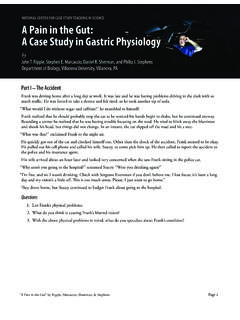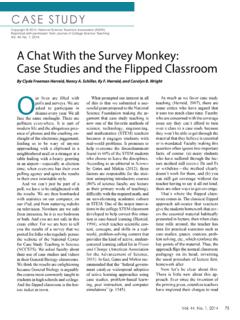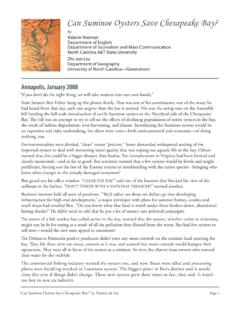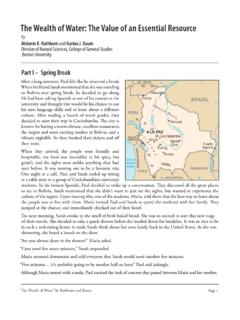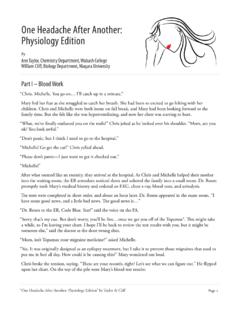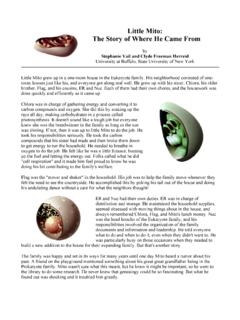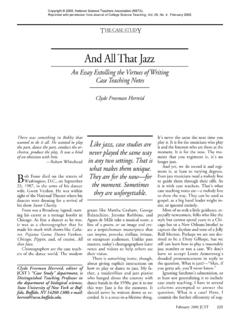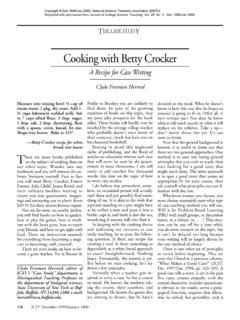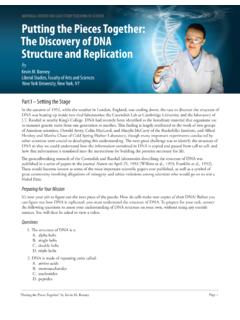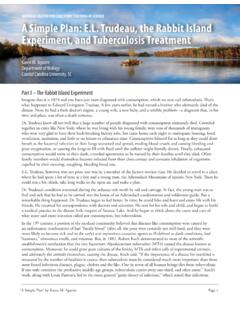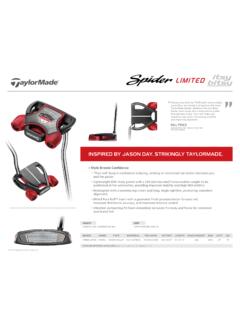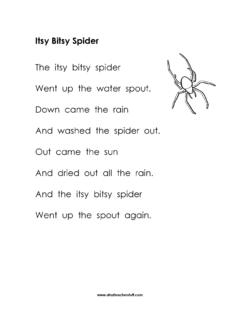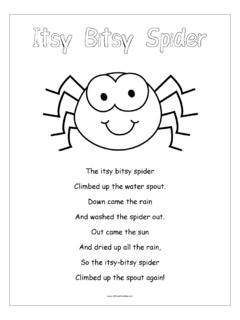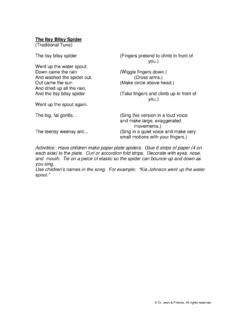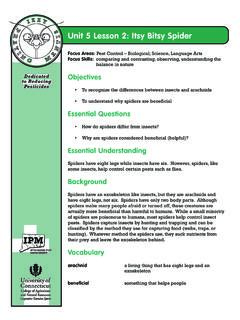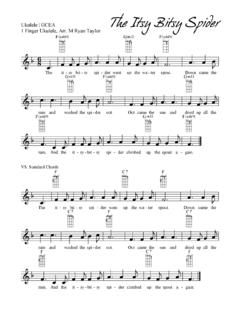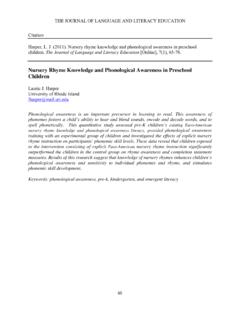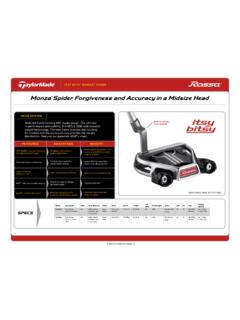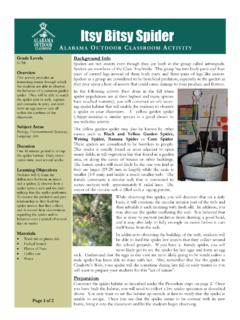Transcription of NATIONAL CENTER FOR CASE STUDY TEACHING IN SCIENCE …
1 Page 1 Th e Itsy- bitsy spider by Bruce C. PalmquistNATIONAL CENTER FOR case STUDY TEACHING IN SCIENCEPart I IntroductionUnderstanding the relationship between form and function in organisms can increase our knowledge about natural processes, especially when it comes to investigating how physical laws apply to the adaptive design of organisms. Th e mode of locomotion plays a major role in the evolution of many body traits. Most terrestrial organisms walk or run upright on horizontal surfaces. Organisms that climb on vertical surfaces or hang from objects most likely evolved, through natural selection, specialized modes of locomotion to optimize ease and rate of order to move, animals need to build up energy and then use that energy in a controlled way.
2 One way to do that is through the interchange of kinetic and gravitational potential energy. One method to do this is an animal moving forward over a stiff ened leg. In the initial part of the cycle, some of the kinetic energy used to propel the animal forward also raises its CENTER of mass, increasing its gravitational potential energy. As the CENTER of mass falls, gravitational potential energy is converted back into kinetic energy which facilitates the next step. Th is is called the inverted pendulum model (Figure 1).
3 Another model is the spring-loaded inverted pendulum model (Figure 2) in which the elastic elements in the leg store energy. As the CENTER of mass moves downward under the force of gravity, the elastic elements in the leg (muscles, tendons, skeletal structure) are compressed. When these elements return to equilibrium, the CENTER of mass is propelled upward and forward. Studies of daddy longlegs of the species Leibunum vittatum seem to follow this mode of locomotion (Sensenig and Schultz, 2007).
4 Th e third model is a regular pendulum model, which gains kinetic energy by swinging from a position of relatively high gravitational potential energy to a low position where kinetic energy is maximized (Figure 3). Hanging spiders most closely match this mechanical model (Moya-Lara o, Vinkovi , de Mas, Corcobado, & Moreno, 2008).Figure 1. Inverted pendulum model. Body CENTER of mass moving, supported by a stiff ened 2. Spring-loaded inverted pendulum model. As a body moving forward brakes, it stores energy in the I IntroduBruce C.
5 PalmquistDepartment of Physics and SCIENCE Education ProgramCentral Washington University, Ellensburg, WAbyThe Itsy- bitsy spider : An Analysis of spider LocomotionNATIONAL CENTER FOR case STUDY TEACHING IN SCIENCEPage 2 Th e Itsy- bitsy spider by Bruce C. PalmquistSpiders are a highly diverse group of terrestrial predators that are exceptional organisms to test evolutionary hypotheses about pendulum mechanics because there are many species that move primarily upright on a horizontal surface (picture a tarantula) and many that live hanging upside down (picture the spider that startles you by dropping from the ceiling).
6 Natural selection is the gradual, non-random process by which biological traits become more or less common in a population due to diff erential reproduction. For example, a spider group with a body type that lets it move quickly to avoid predators will live longer and have a greater opportunity to pass that favorable trait on to its off Other InformationHere are some physics concepts to help you analyze the case : A pendulum at the endpoint of its trajectory has energy PEg = mgh where mg is the weight of the pendulum and h is the distance the pendulum is above or below the equilibrium position.
7 A pendulum at the equilibrium point of its trajectory has energy KE = (1/2)mvmax2 where m is the mass and vmax is the maximum speed of the pendulum. Th e energy stored in a compressed spring is given by PEs = (1/2)kx2 where k is a measure of the stiff ness of the elastic medium (called the spring constant) and x is the amount the elastic material is displaced from If you designed an animal that could walk on fl at horizontal surfaces and move upside down on suspended surfaces, describe three body characteristics you would give that animal.
8 Be specifi c. Don t just say something generic like legs that can walk and grip. 2. What is the basic question of this STUDY and why might it be an interesting and relevant topic for scientists to STUDY ?3. What specifi c and measurable hypotheses (at least two) can you develop that are supported by the information presented and that address the basic question of this STUDY ?Figure 3. Regular pendulum model. Body CENTER of mass swinging like a regular CENTER FOR case STUDY TEACHING IN SCIENCEPage 3 Th e Itsy- bitsy spider by Bruce C.
9 PalmquistPart II HypothesesIf the evolution of body shape matches simple pendulum mechanics, animals that move suspending their bodies should evolve relatively longer legs, which must confer high moving capabilities (Moya-Lara o et al., 2008).Leg Length HypothesisIf leg length is the target of natural selection, hanging animals must have evolved disproportionately longer legs relative to their body size when compared with animals that walk standing on their legs. Running HypothesisAs spider size increases, running speed should increase with a greater increase for standing rather than hanging Rewrite the leg length and running hypotheses of this STUDY in your own words using the If, then, because format.
10 Th is hypothesis must be something you can measure and observe in a short-term Describe how you could use the concepts of kinetic and potential energy to analyze the motion of a Which of the two models of upright locomotion described in the introduction (inverted pendulum or spring loaded inverted pendulum) would benefi t a long-legged spider running upright? Why?4. Does the regular pendulum model favor a long-legged or short-legged spider ? Why?5. Design an experiment to test the leg length hypothesis. Describe the basic procedure, number of trials, equipment needed, and method of Design an experiment to test the running hypothesis.
